By Bojana Coulibaly
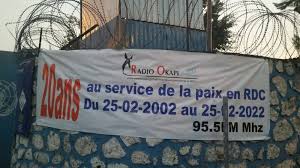
Source photo: Monusco
On March 29th, the UN news platform Radio Okapi, published a news update titled “La population de Goma ‘sous la brutalité’ du M23 appelle à l’intervention de la communauté internationale (témoignages)” [Goma residents ‘under the brutality’ of M23 calls for the intervention of the international community (witness testimonies)].
In this reporting, critical methodological flaws and a breach of standards of journalism can be observed. Since the beginning of the conflict, Radio Okapi has failed to constitute an objective source of information on the situation in DRC, and to contribute in promoting peace, while claiming to be “broadcasting 24h for peace”. This questions the role played by the United Nations and its 26-years-long, $40-billion-worth peacekeeping mission in DRC. It also questions the neutrality of the UN in this conflict in which its media Radio Okapi spreads propaganda, attacking a UN member state, namely, Rwanda.
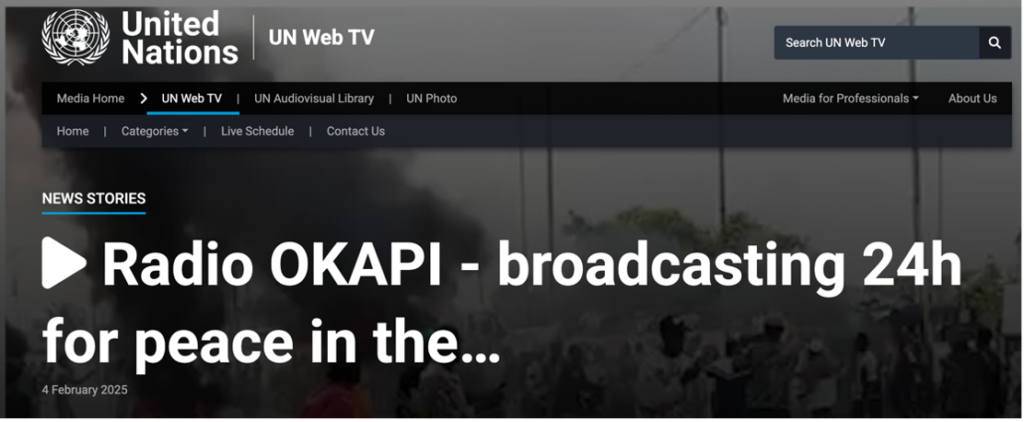
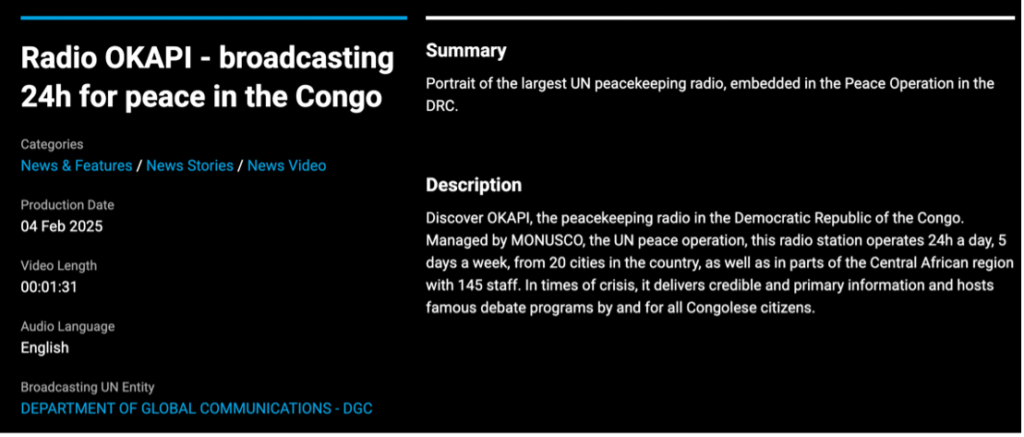
The “anonymous” testimonies of Radio Okapi
Throughout this March 29th news update, Radio Okapi uses what they refer to as “anonymous” sources. This leaves no option to cross check Radio Okapi’s accusations, forcing the reader to exclusively depend on Radio Okapi as a source.
A common disinformation and propaganda tactic consists in failing to reference one’s source of information. Accordingly, Radio Okapi here reports on an alleged “brutality of M23” using non-identifiable sources: “la population de Goma” (Goma residents), “plusieurs témoignages” (several testimonies), “des jeunes hommes” (young men), “l’accusation la plus fréquente” (most frequent accusation), “habitants sous anonymat” (residents speaking anonymously), “le frère d’une victime” (the brother of a victim), “acteurs de la société civile” (actors of civil society).
Radio Okapi justifies the use of anonymous sources by the claim that Goma residents are in fear of reprisal. However, they present no evidence to sustain that claim.
Amnesty International: an unreliable and partisan source
One single source designated in the news update is Amnesty International. The choice of using Amnesty in this particular story, while lacking any other identifiable source, is deliberate. Its “reputation” serves as a token of trust. However, since the beginning of the conflict, Amnesty International has not been an objective source of information. In fact, the researcher covering DRC for Amnesty is Jean-Maubert Senga, who before joining their team, was an active LUCHA member, as he explains on his X social media platform at the occasion of the 10th anniversary of LUCHA.
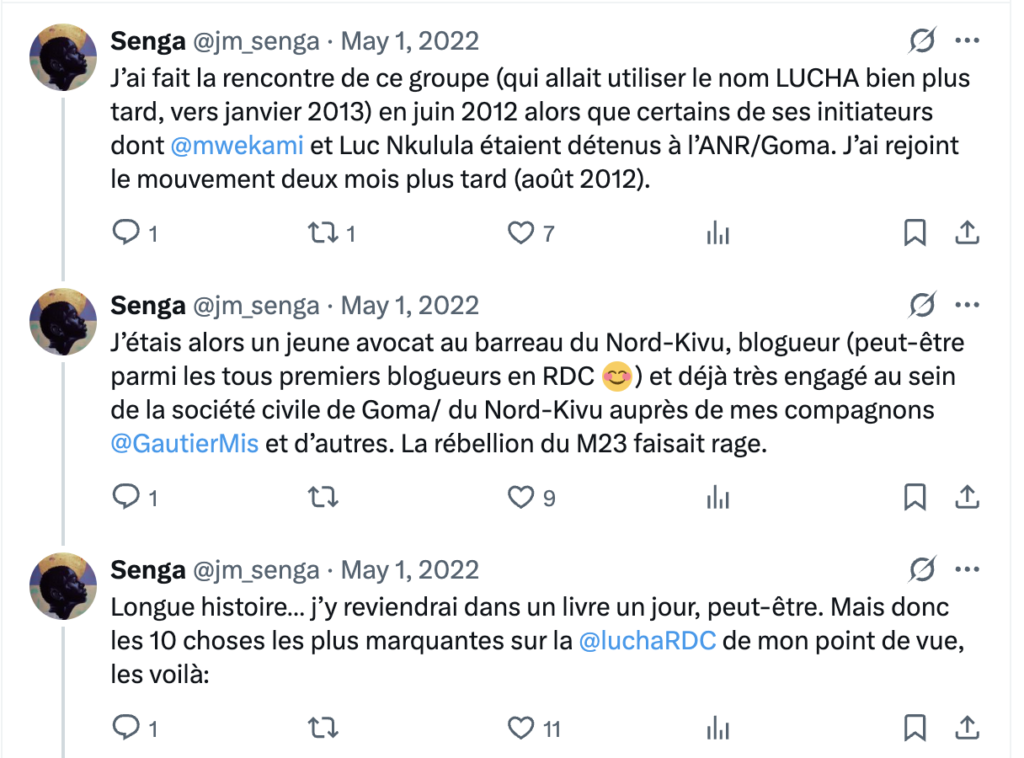
Since Jean-Maubert Senga covers DRC for Amnesty International, he represents Amnesty’s source of information.
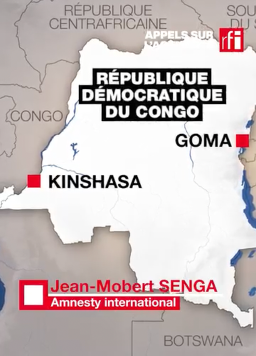
Nonetheless, when he was both a LUCHA member, and an Amnesty researcher, Senga has been promoting hate speech, denialism, and hate ideology. This is particularly reflected on his X platform.
In one post in 2014, Senga asks in a provocative tone whether the newly appointed Rwandan prime minister, Anastase Murekezi, is “Hutu” or “Tutsi”, calling it a “taboo” question. Senga is perfectly aware that a divide between artificially created “Hutu” and “Tutsi” “ethnic” and “racial” categories during colonial times, was politically implemented in Rwanda by Belgium during the first half of the twentieth century, leading to the extermination of 1 million Tutsi by Hutu Power militias and a genocidal regime in 1994. The fact of even writing the terms “Hutu” and “Tutsi” as hashtags in his post on X, illustrates Senga’s obsession about these false racial categories created by the colonial explorers and administrators to manipulate ethnic identities for political and economic gain. The kind of tribalist hate rhetoric that Senga engages in, on social media, is dangerous and constitutes hate speech.
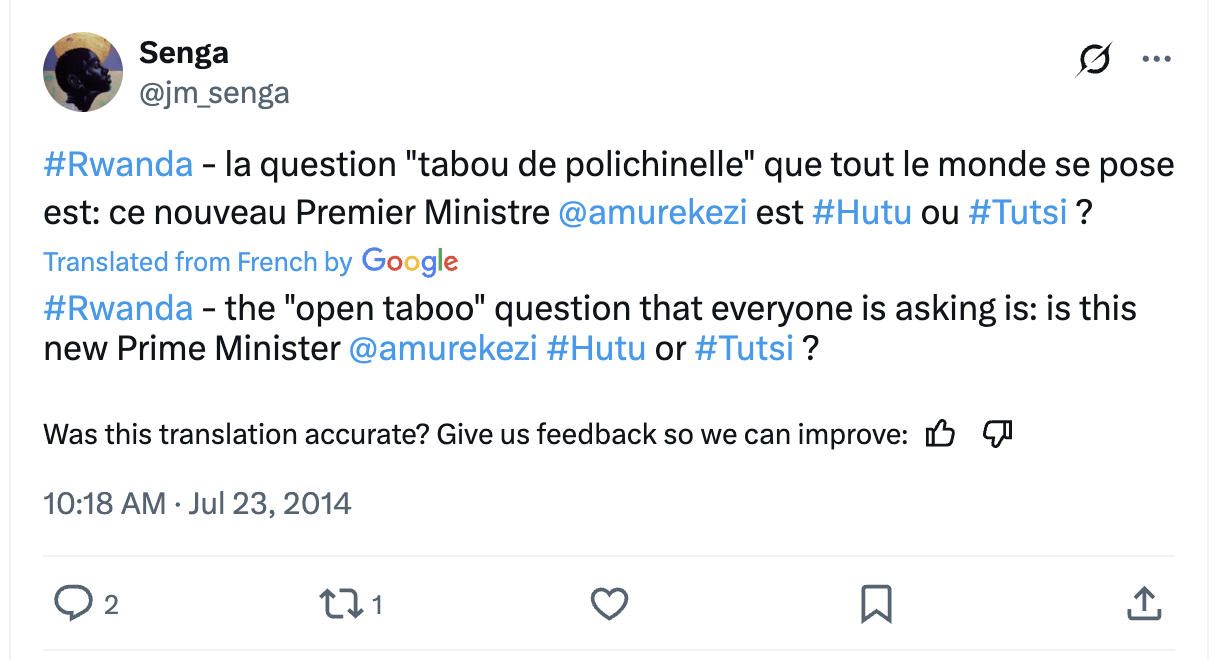
Similarly in a post in 2019, Senga borrows the hate rhetoric which was used in 1959 when Belgium supported and incited Hutu extremists to seize power in a so-called “social revolution”, based on the argument of a numerical “ethnic majority” of “Hutu” over “Tutsi”, which led to anti-Tutsi pogroms, culminating in the 1994 genocide against the Tutsi in Rwanda. In this post, Senga referring to eastern DRC, claims that the power is in the hands of a Tutsi minority, which according to him rules over a Hutu and Nande majority. This rhetoric, used by the masterminds of the genocide against the Tutsi, incites certain groups “to eliminate” others, and this narrative has been at the basis of the persecution, killing, and exile of Congolese Tutsi for decades.
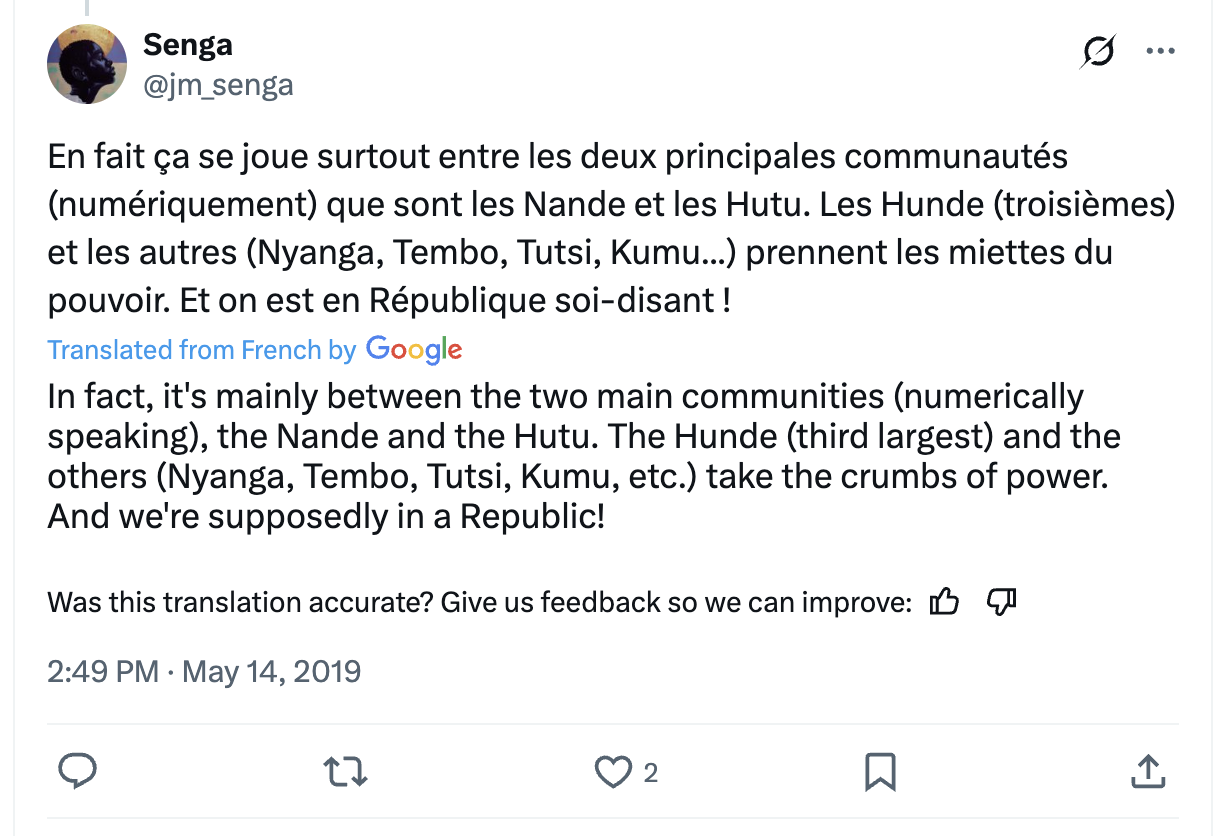
To add to Senga’s promotion of hate speech, he engages in a denialist discourse either supporting common denialist theories or known genocide deniers and ideologues.
In his recent post on the controversial “Solidarité Congo” concert, which was scheduled to be held in Paris on April 7th, the day of the commemoration of the 1994 genocide against the Tutsi, Senga argues that the genocide started on April 6th, and not April 7th. This is one of the main genocide denial theories used by notorious genocide deniers such as Charles Onana, convicted for genocide denial in a French court in December 2024. This theory contends that a genocide was never planned in Rwanda, but that it is the shooting of Habyarimana’s plane, on April 6th, that “sparked popular violence”, which, according to Onana and other deniers, resulted in the mass killings of “Hutu, Tutsi, and Twa.” This allows them to deny genocide, as both the planning of the genocide and the clear identification of the targeted group are erased. This denialist theory has often been used by Congolese officials as an electoral and political tool, to instigate anti-Rwanda hate, and deviate attention from the current Kinshasa’s regime failure.
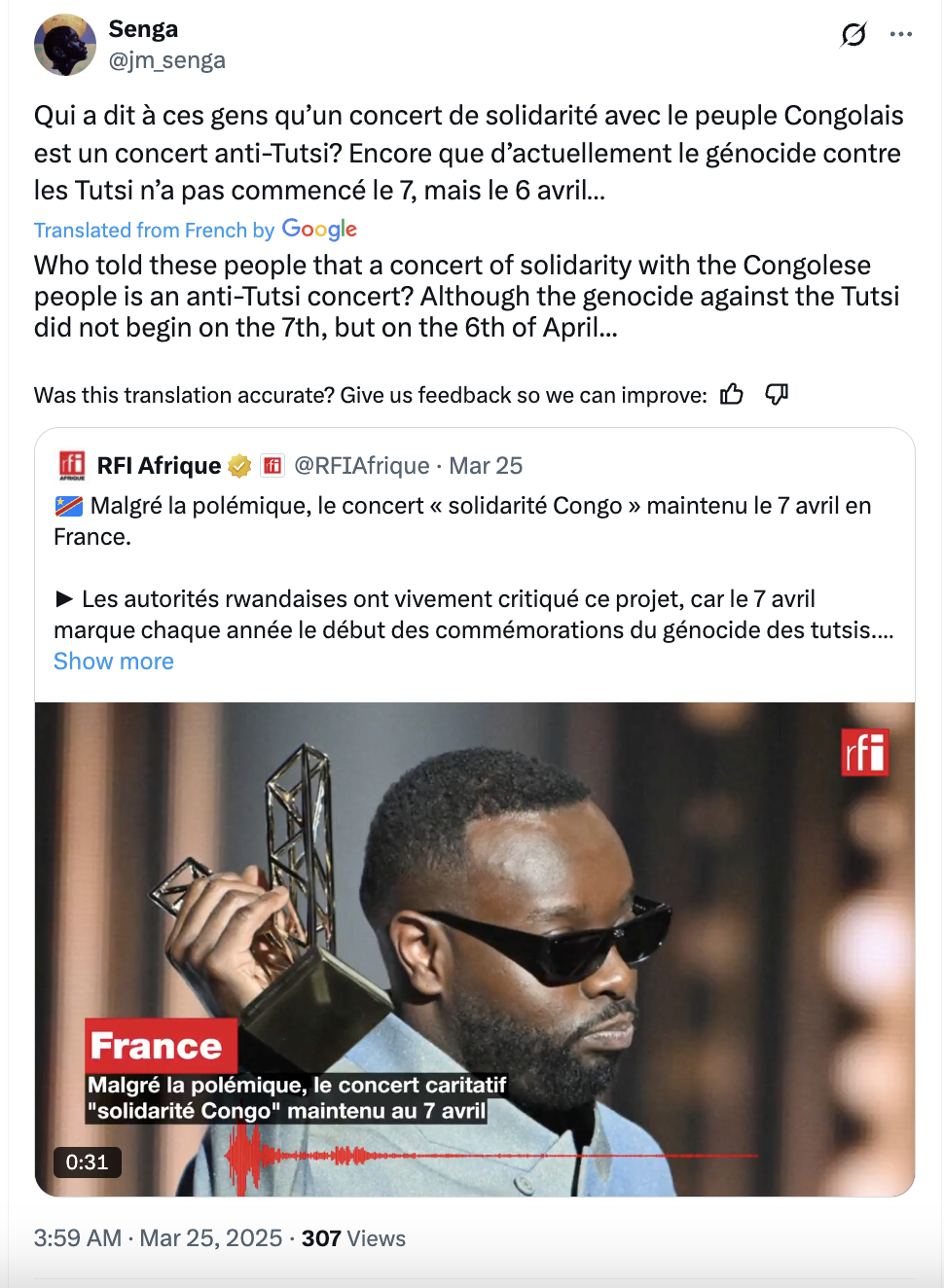
For instance, a couple of days ago, on March 27th, the Congolese ambassador to the UN, Zénon Mukongo Ngay, during a UNSC hearing on the situation in DRC, used this same denialist theory. He was responding to the Rwandan Minister of Foreign Affairs, Olivier Nuhungirehe, who reiterated that the root cause of the current conflict is the collaboration between the FDLR and the Congolese government, which represents a security threat for Rwanda. The Congolese ambassador responded that “the genocide started with the assassination of president Habyarimana. That is the origin of today’s conflict.” He is implying here that, it is not their collaboration with FDLR which is the cause of the current conflict, but the idea, which the Congolese government has consistently supported in the last 3 years, that Rwanda wants to “expand its territory”, in other words, to create “a Hima-Tutsi Empire”. This use of a conspiracy theory and the complete distortion of facts serve the Congolese ambassador and the government he represents, to whitewash their collaboration with the genocidal force FDLR and their endorsement of FDLR-Interahamwe genocide ideology.
Senga in this post not only fails to acknowledge that the date chosen for the concert constitutes a direct attack on the memory of 1 million people killed in the genocide, on the grief of their families and of survivors, but he also fails to denounce that the choice of the lead artist invited to perform at the concert, Maitre Gims, constitutes a problem in itself, as he is a known hate speech activist.
The artist has indeed openly used anti-Tutsi hate rhetoric in a song in which he stated that “it’s not orange juice that can calm the hatred of a Tutsi”. This statement constitutes hate speech as it designates an entire group, i.e., the “Tutsi” or those perceived as “Tutsi”, as “natural born haters”.
Maitre Gims is also known for the hate rhetoric directed at the Rwandan Head of State, Paul Kagame, who led the Rwandan Patriotic Army, which stopped the genocide against the Tutsi in July 1994. In another song, the artist says that “Kagame rime avec croix gammée” [Kagame rhymes with swastika]. This sustains the anti-Tutsi and anti-Kinyarwandophone hate narrative widely present in DRC, preventing any resolution to the ongoing conflict, and jeopardizing the lives of Congolese Tutsi, as well as of those perceived as Tutsi, based on their physical features. LUCHA’s founder Fred Bauma, and DRC president Felix Tshisekedi, both publicly called Paul Kagame “Hitler”, inciting a hate ideology that Senga here promotes, rather than denouncing it.
Senga’s support for Victoire Ingabire, is another demonstration of his denialism and promotion of genocide ideology. Not only Ingabire was convicted for genocide denial, but she has been cited in a UN report for having supported the genocidal force FDLR, responsible for the violence in DRC in the last 30 years.
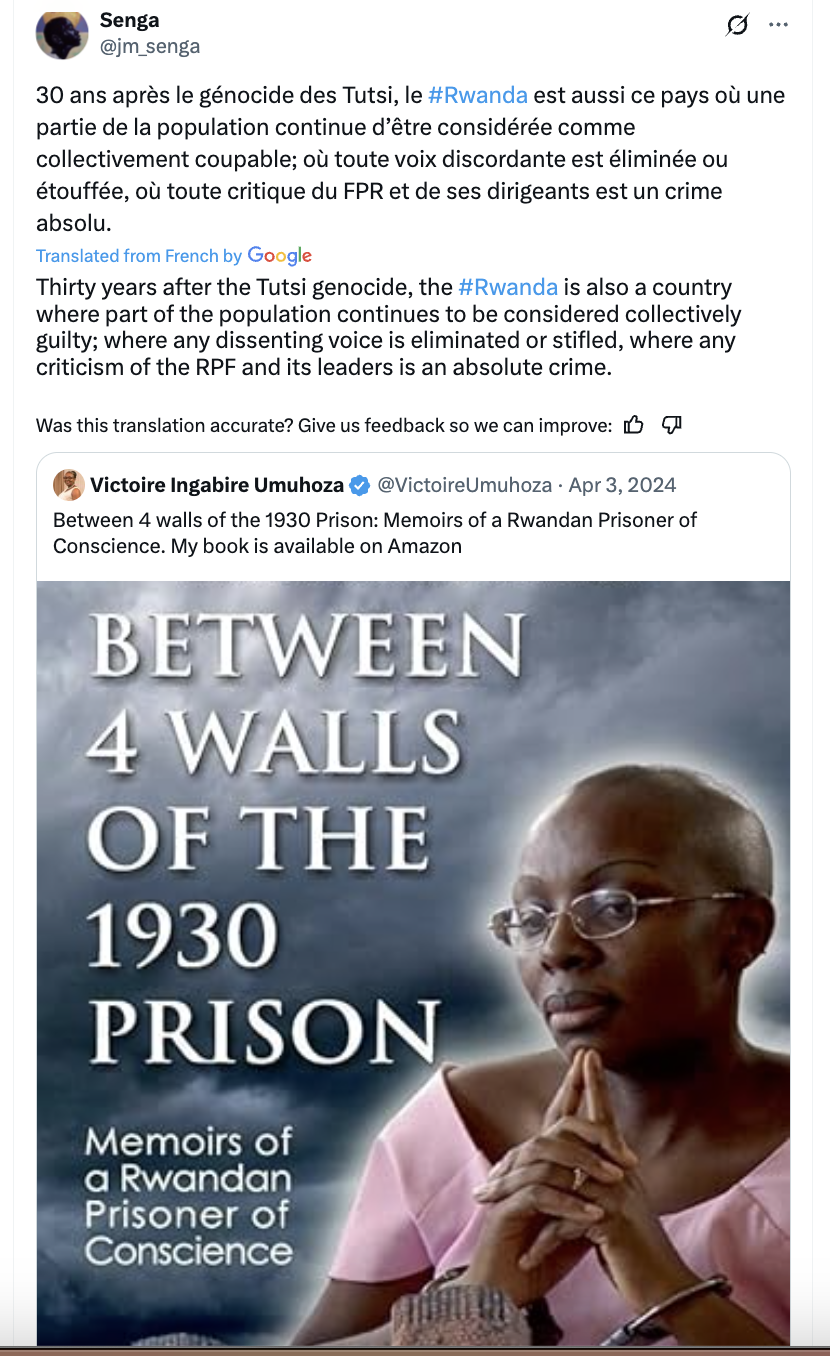
While Victoire Ingabire has been openly promoting anti-Tutsi genocide ideology, supporting the FDLR, and the Wazalendo who have been trained by FDLR and its splinter group Nyatura, to target Congolese Tutsi, Senga here is deploring her alleged experience of “freedom repression” or “censorship” by Rwanda. And yet, Ingabire has not only published multiple times in well-known media, but she is promoting in this X post her own book without being targeted by any form of state censorship, whether of her book or of her X account. This is despite her book directly criticizing the Rwandan government.
What is more, in November 2022, the USG for genocide prevention, Alice W. Nderitu, has denounced the systematic targeting and persecution of Congolese Tutsi, constituting acts of genocide, which added to a number of other reports about the occurrence of lynchings, acts of cannibalism, systematic attacks targeting Congolese Tutsi, their livestock, and property. Senga however, in May 2023 in an X post, attacked Dominic Johnson and Simone Schlindwein, whose reputation as journalists has been recognized thanks to their in-depth reporting on DRC for over a decade and to the seminal book that they co-authored on FDLR. Senga claimed that their warnings of genocide against the Tutsi in Congo, “fuel a narrative that has nothing to do with reality”. He chooses to deny the multiple warnings made by the Congolese Tutsi, while stating that those who denounce their plight are “blood merchants”.
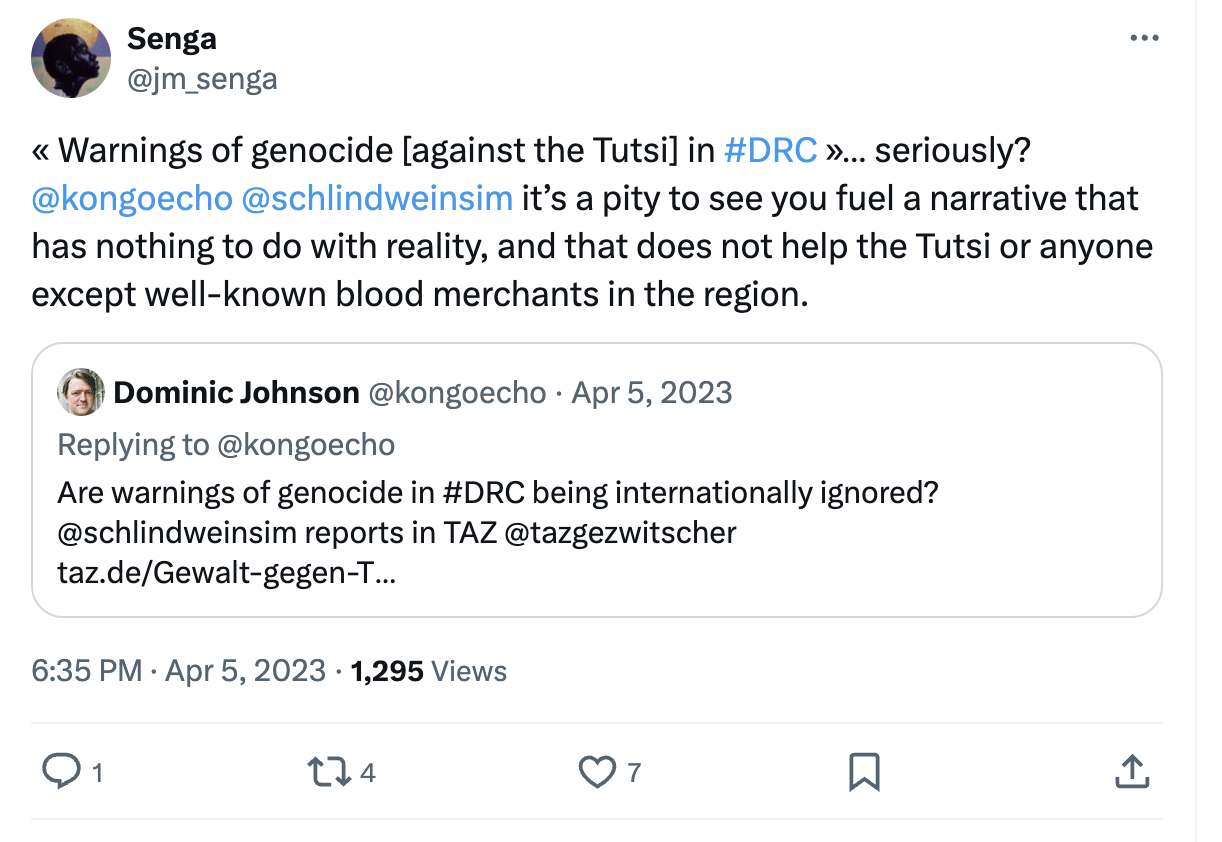
Senga reposted today the news update of Radio Okapi, and without any demonstrated evidence, accuses M23 of “executions, flogging, kidnapping, and extortions”.
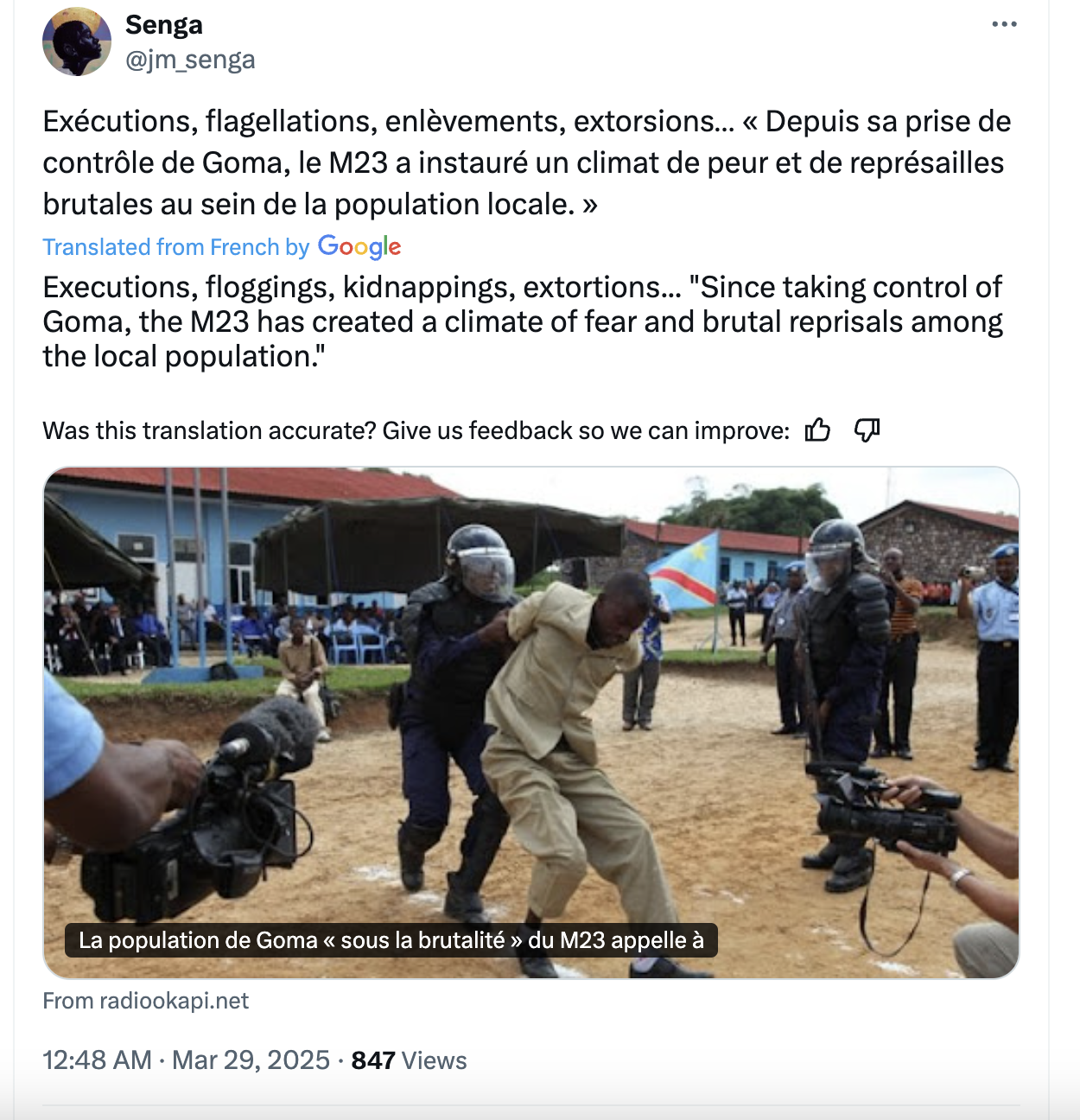
The vilification of M23 through LUCHA’s false reporting
This particular campaign of vilification of M23 and Rwanda has been fueled by LUCHA members, who are referred to in the Radio Okapi news update as “actors of civil society”, and who have been feeding anti-M23 fabricated reports in the last 2 months since M23 has been in Goma, as illustrated on their posts on X.
In one instance they show a video of men in the dark, with one man being beaten with a stick. The poor quality of the video makes it impossible to identify any of the subjects in the video or the group they belong to, if any. The date and exact place where this video was taken is also not provided. So, LUCHA simply posts a message about alleged “acts of torture” and “degrading treatment” “by M23”, with a video that doesn’t show anything.
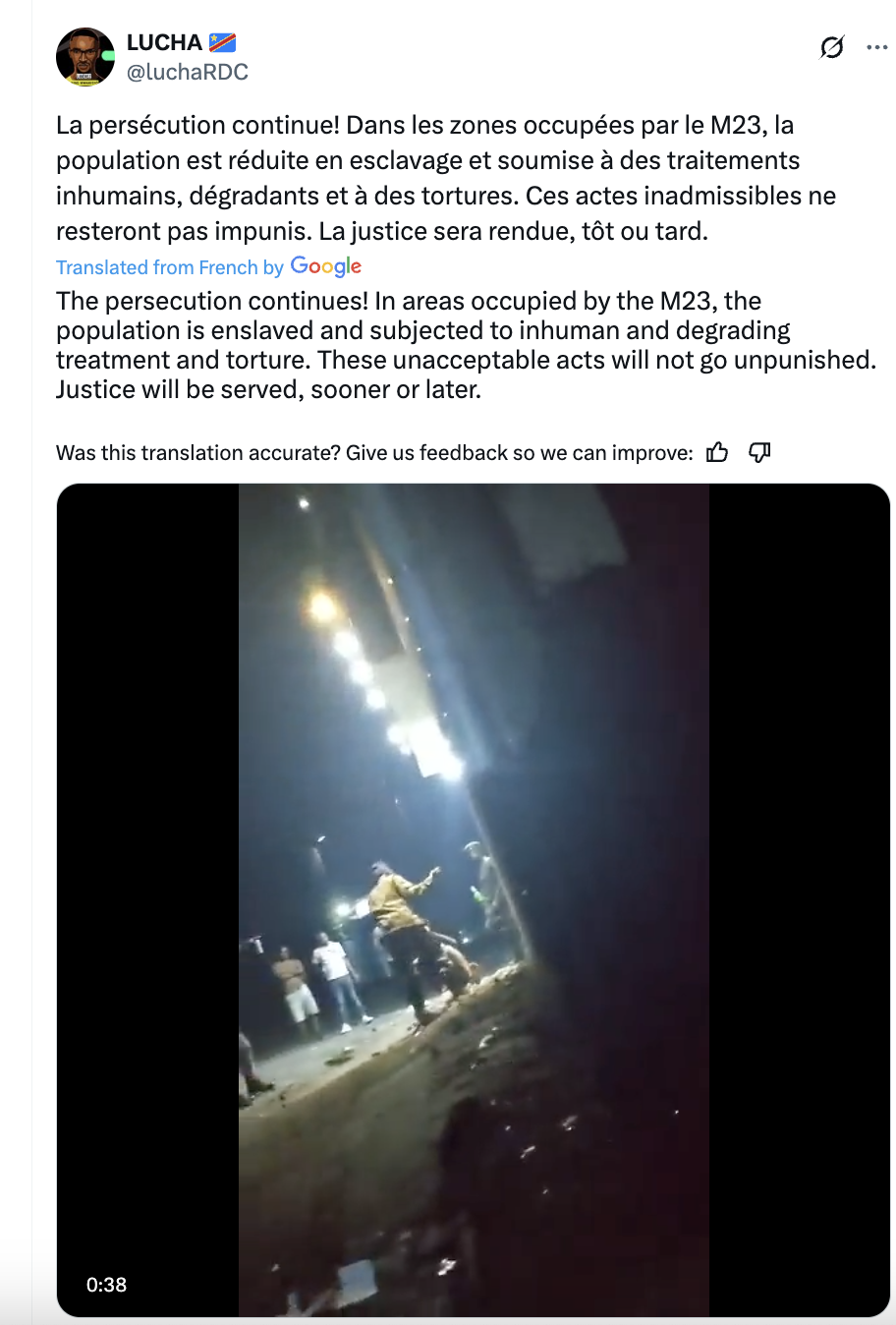
In another instance LUCHA is using a drunkard that they have likely paid to accuse M23 (and Rwanda) of “forcibly recruiting young men in Goma”. This video lacks full credibility as it is failing to show any evidence of forced recruitment by M23.
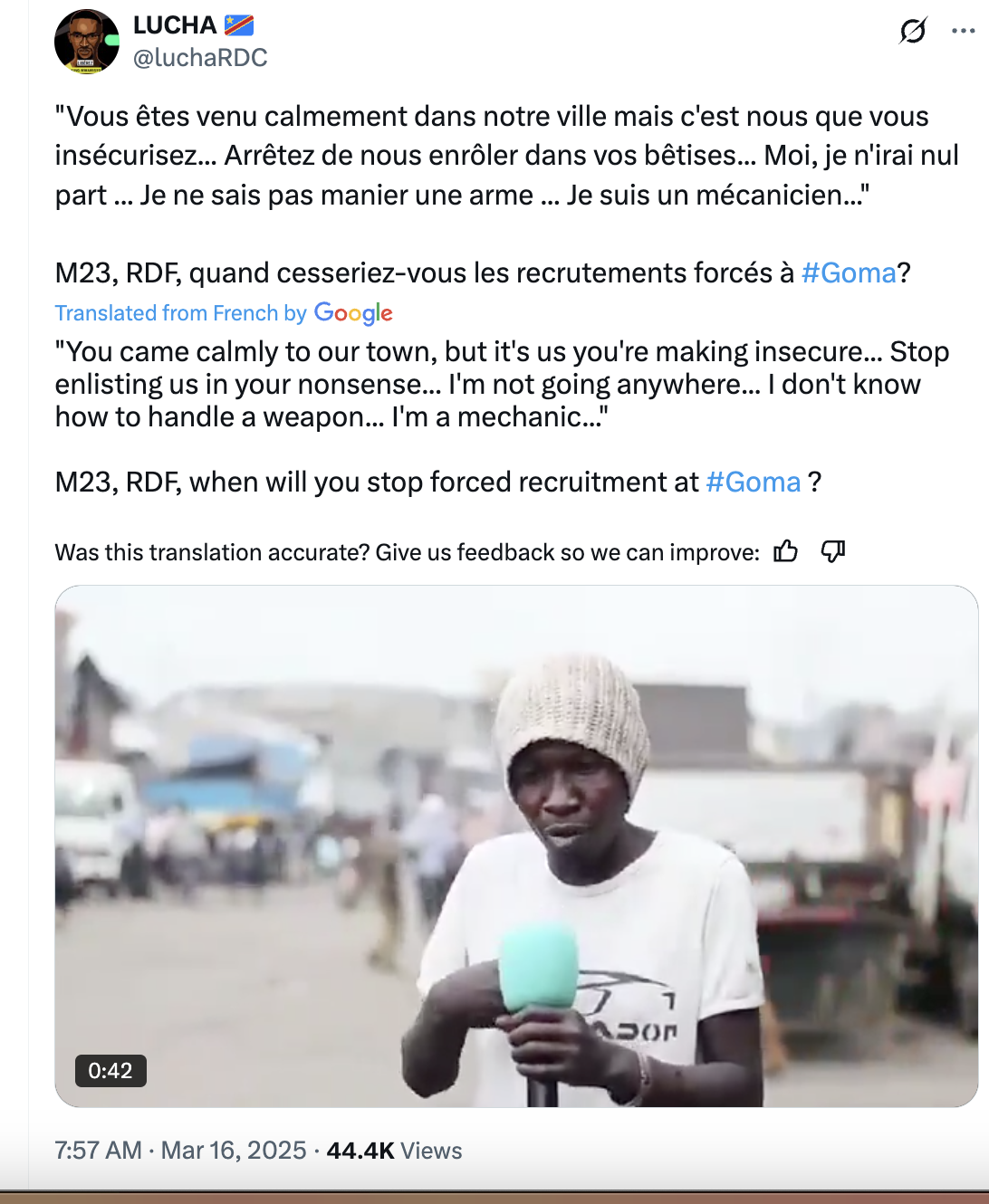
In another post, they are accusing M23 (and Rwanda) of attacking the Heal Africa hospital in Goma without investigating the claim or presenting any evidence.
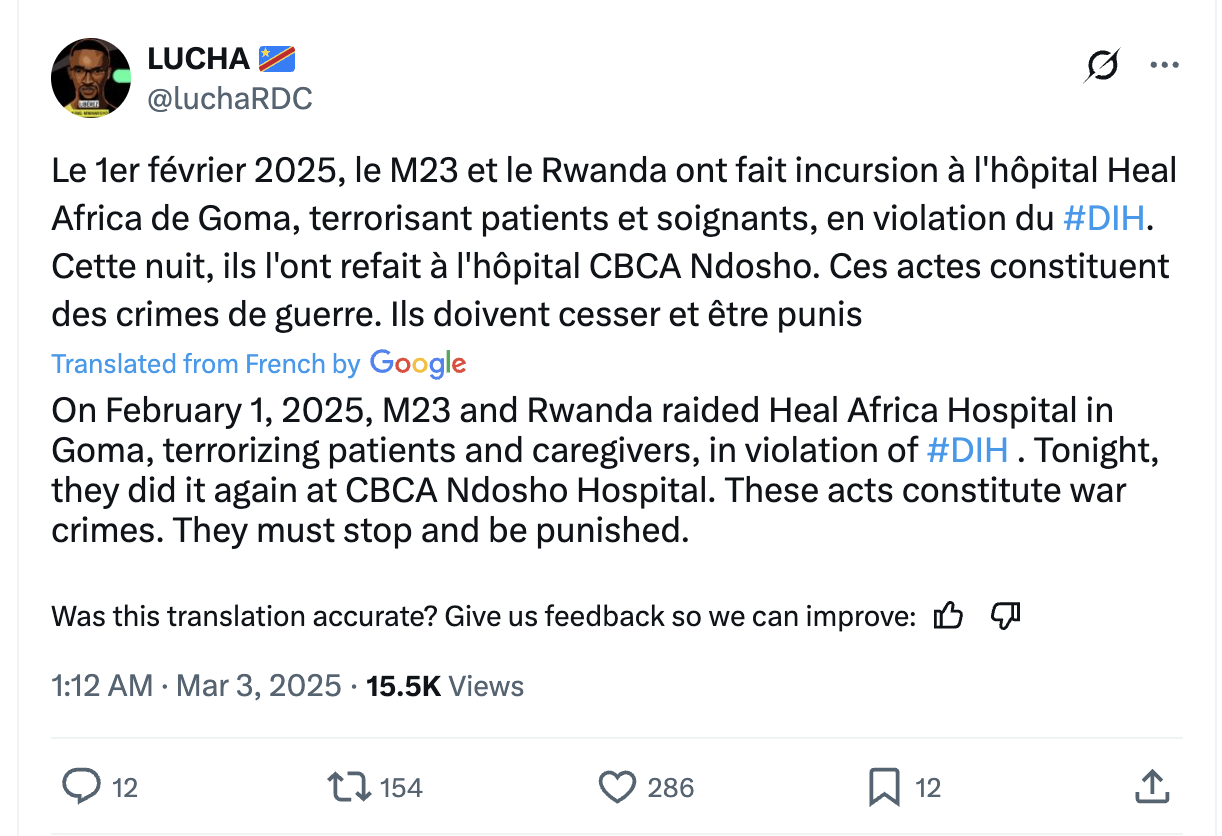
The same goes for the accusation of M23 allegedly killing 4 civil society activists. All the claims are based on rumors that conveniently accuse M23, without ever showing any evidence.
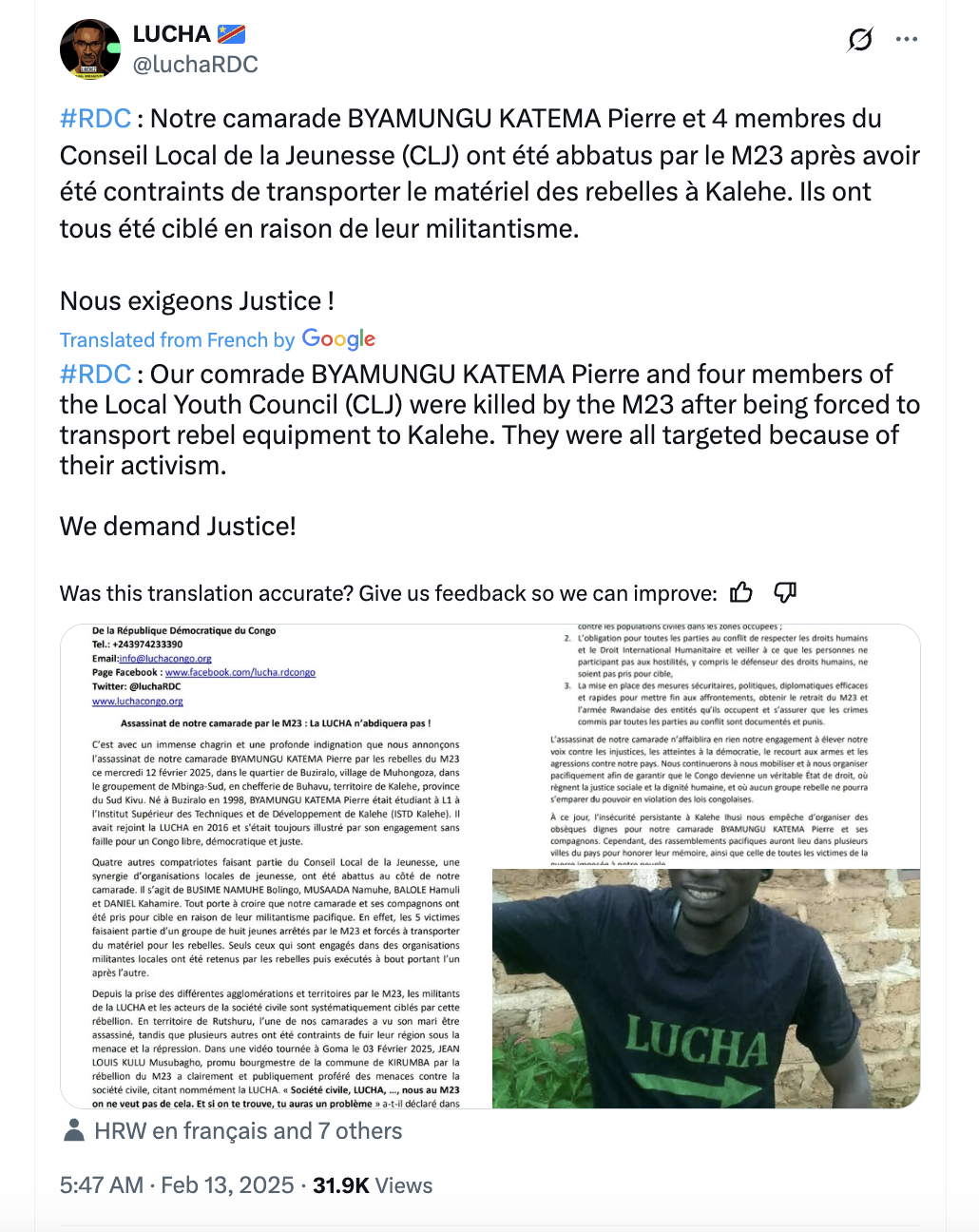
Similarly, the number of “3000 dead in the offensive on Goma” which they are promoting, has been widely contested by journalists and humanitarian organizations. Yet, LUCHA is maintaining the story, which was started by MONUSCO, itself unable to conduct any investigation or provide evidence, equally failing to indicate who the “3000 dead” are.
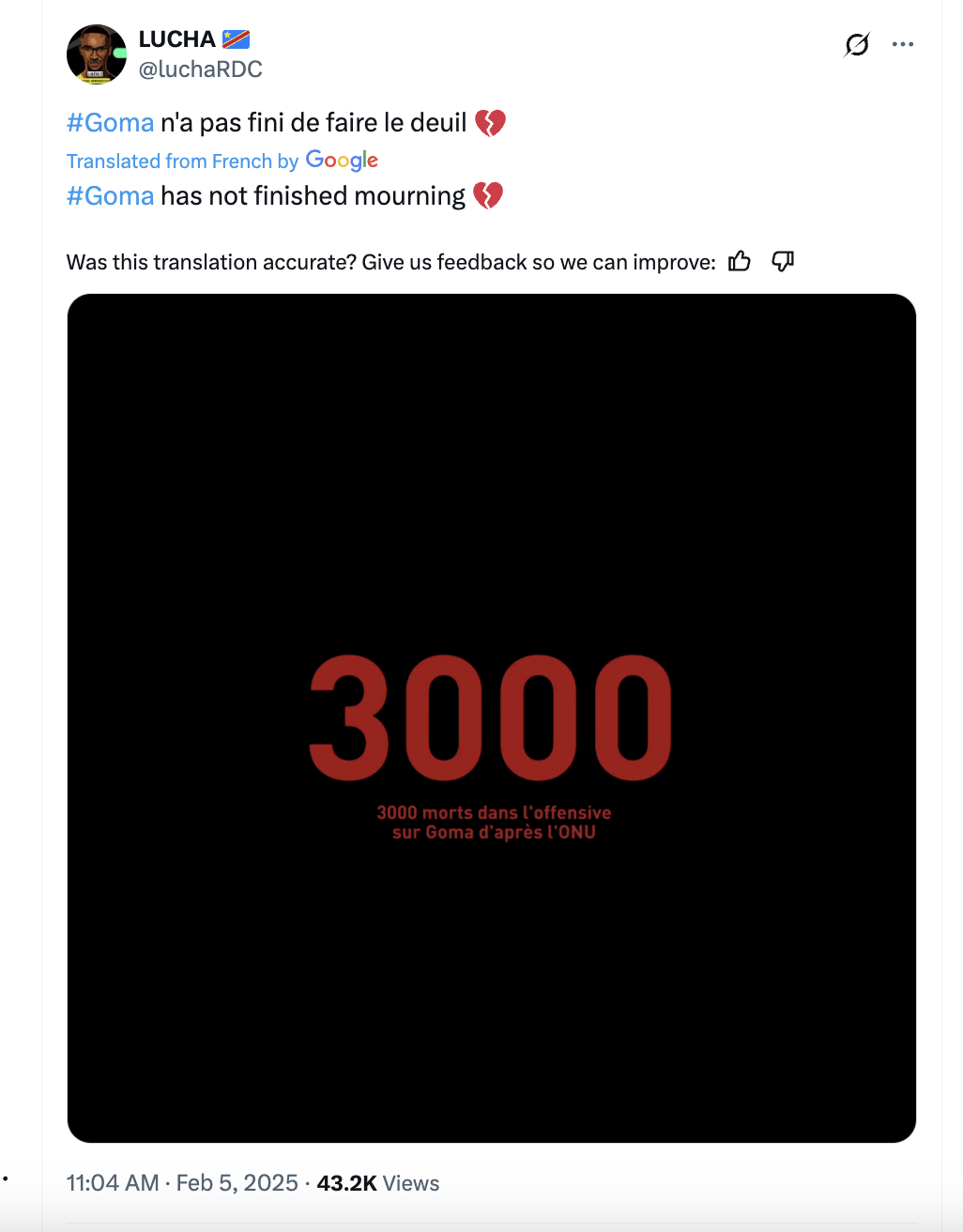
This type of inflation and random reporting of the number of casualties, without investigation and evidence, has been a common tactic used by Kinshasa, in conjunction with LUCHA, MONUSCO, Human Rights Watch, and Congo Research Group, in order to fuel anti-M23 and anti-Rwanda sentiment. A case in study was their reporting on the so-called “Kishishe massacre” which allegedly took place in November 2022.
If none of Radio Okapi’s sources are credible, then what about Radio Okapi itself and MONUSCO that sponsors it?
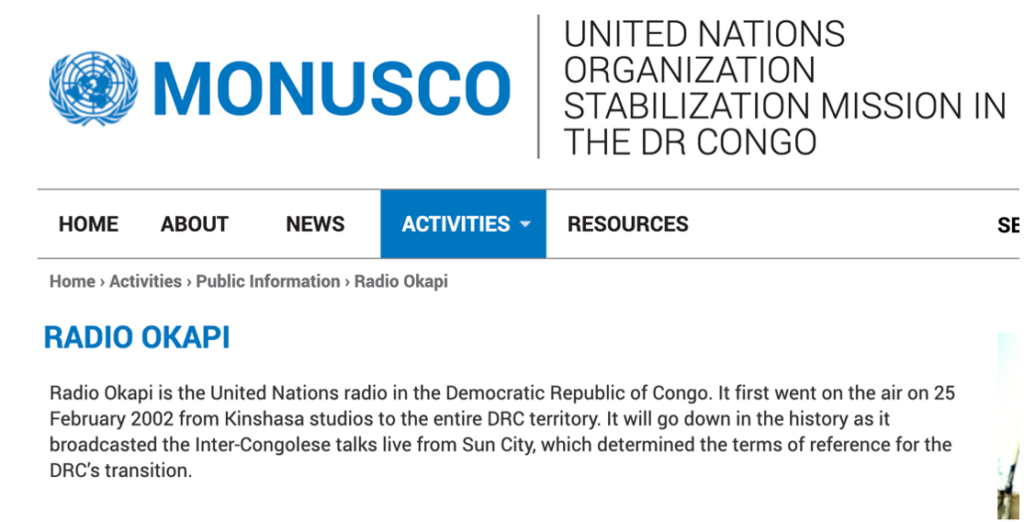
MONUSCO’s support of Kinshasa’s coalition in its war against M23 is no longer contested. MONUSCO has not only established a Joint Operations Center in Goma, and then in Beni, where all the military operations have been conducted in coordination with FARDC, but it has openly and publicly declared providing logistical, operational and intelligence-based support to the DRC government. This is despite the fact that MONUSCO knows that the DRC government collaborates with FDLR and other negative forces such as Nyatura, a plethora of other armed groups, as well as FARDC reserves under the VDP or Wazalendo banner. This is in addition to its collaboration with the Burundian National Defense Force (FDNB), over 1000 European mercenaries, and until recently, the South African, Tanzanian and Malawian forces of SADC, who have surrendered when M23 took over Goma, and who are now withdrawing after SADC and M23 signed a peace agreement this week.
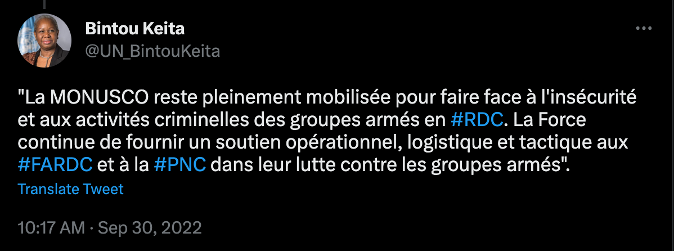
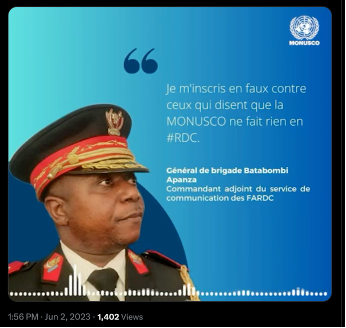
MONUSCO’s partisan posture in favor of the DRC government against M23 has been widely evidenced. For example, in a statement in January 2023, published on MONUSCO’s X account, FARDC Brigade General Batabombi Apanza declared:
“Through MONUSCO’s drones, we obtain intelligence on the location of the enemy, which enables us to carry out surgical strikes. We also have air and artillery support. Monusco provides us with medical support… Monusco supports the FARDC in securing towns… Monusco supports the FARDC in technical, tactical and moral training. The FARDC work with all Monusco’s substantive sections to reinforce certain operational capacities of our armed forces… This list is not exhaustive…”
How MONUSCO went from being tasked to solve a problem, to being part of the problem by breaching its neutrality
In July 28th-29th, 2022, USG for Peace Operations Jean-Pierre Lacroix, flew to Kinshasa and met with the Congolese authorities, following violent anti-MONUSCO demonstrations, commissioned and funded by Kinshasa, then executed by LUCHA activists, resulting in the death of peacekeepers, as reported in the December 2022 UN Group of Experts Report.
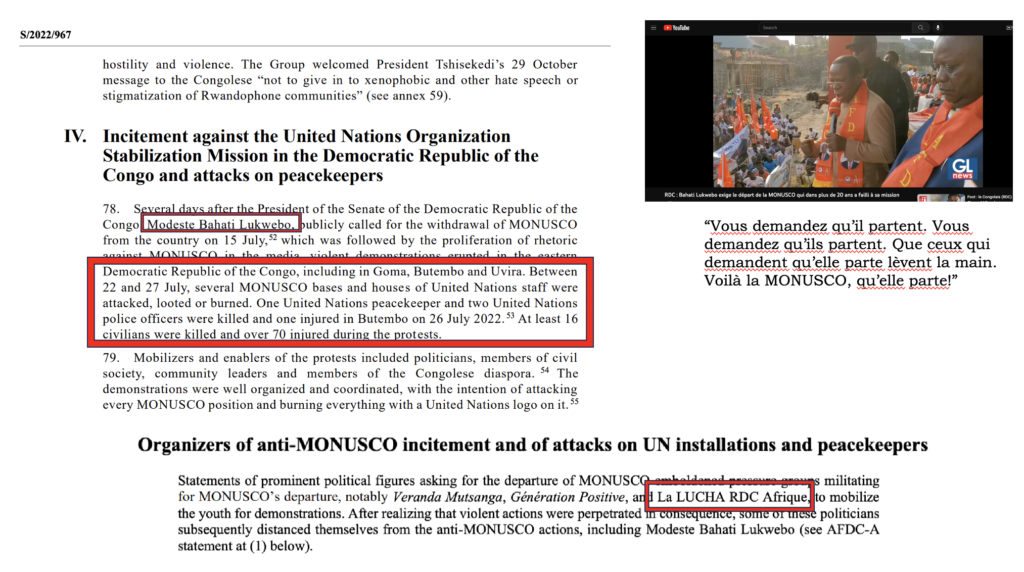
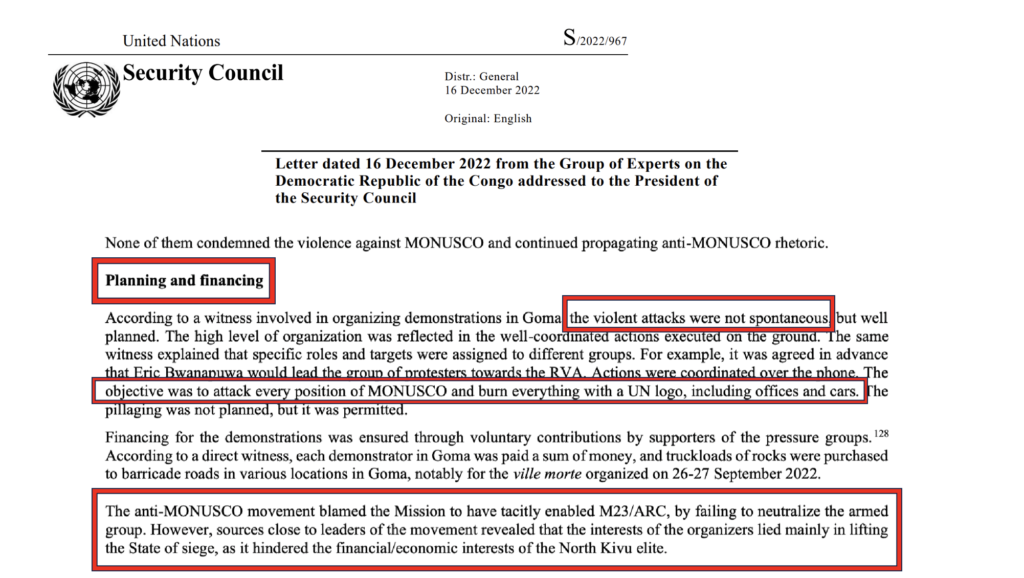
During that meeting, we learn that “Jean-Pierre Lacroix and these senior Congolese officials discussed ways to defuse tensions, strengthen the partnership between MONUSCO and the Congolese government, and rebuild trust between actors to avoid similar incidents in the future.”
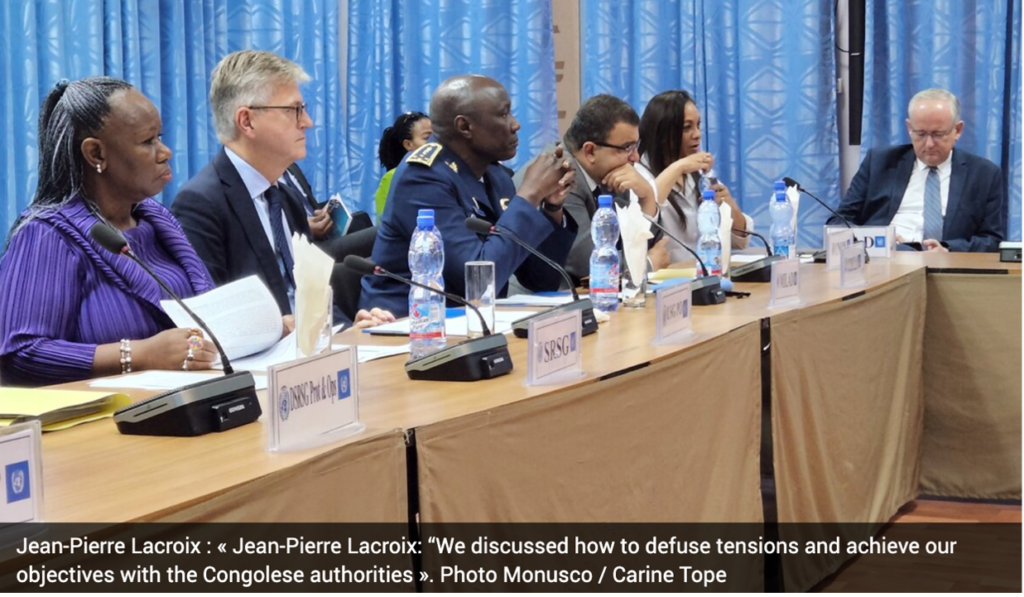
Lacroix, addressing his counterparts, declared: “It is important that we redouble our efforts in transparency, in liaison with the authorities, that everyone does their job. There is work to be done on our side, there is work to be done on the part of the Congolese authorities who recognize that we also communicate in a united and coordinated manner”.
This shows that from then on, MONUSCO had to adopt a new approach, and begin a direct collaboration with Kinshasa, agreeing to any and all of Kinshasa’s conditions, even to be bullied into what Kinshasa wanted, for the sole purpose to not have to leave Congo.
As a result, MONUSCO can no longer be considered as a peacekeeping mission which, in its definition must preserve an impartial role and promote political mediation between the parties to the conflict, in order to make and maintain peace.
What is more, until it joined forces with Kinshasa, MONUSCO was mandated to neutralize FDLR through its Force Intervention Brigade. Yet today MONUSCO is fighting alongside FDLR. So, as a belligerent force, MONUSCO is a part to the conflict and cannot be considered an impartial source of information for Radio Okapi. There is clear conflict of interest, constituting an evident violation of research integrity.
Can Radio Okapi be a reliable source after Kinshasa threatened journalists instructing them to follow Kinshasa’s prescribed editorial line?
After Aljazeera was banned in DRC in January for broadcasting an interview with M23 president Bertrand Bisimwa, Kinshasa, through its Conseil supérieur de l’audiovisuel et de la communication (CSAC), threatened to suspend several media, including Radio France International (RFI), TV5 Monde, and France 24, for reporting “advances by M23 in eastern Congo”, “while ignoring the exploits of the FARDC.” Christian Bosembe, president of CSAS added that “[Kinshasa] respects freedom of expression and information, but … firmly condemns any apology for terrorism.”
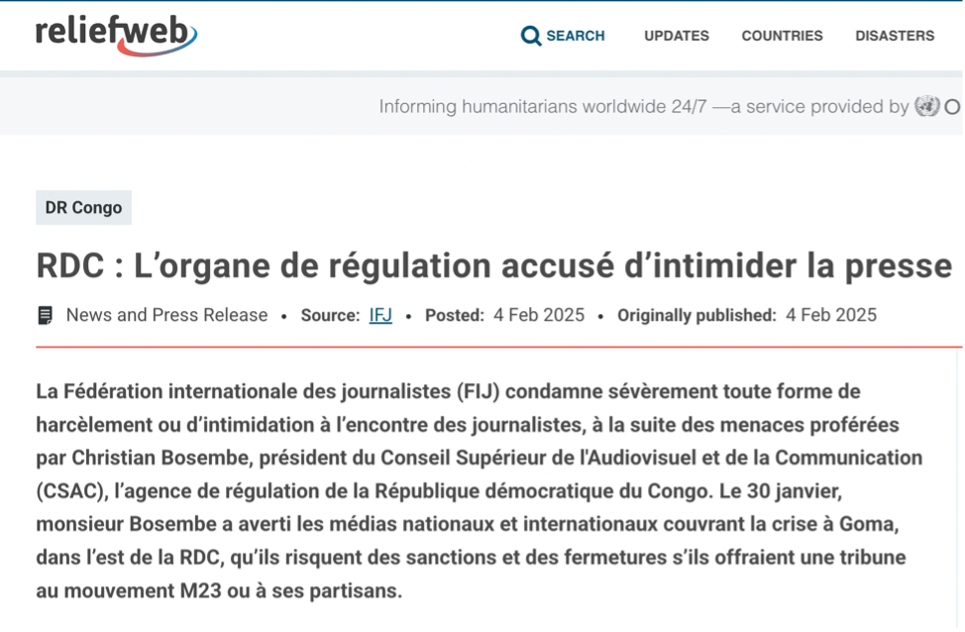
This campaign of intimidation of journalists by Kinshasa was complemented by a death penalty threat by the DRC Minister of Justice, Constant Mutamba, in a post on X, where he stated that if any “political actor, civil society activist journalist, or religious figure… relays the activities of the Rwandan army and its M23 auxiliaries, [they] will suffer the full force of the law (DEATH PENALTY)”.
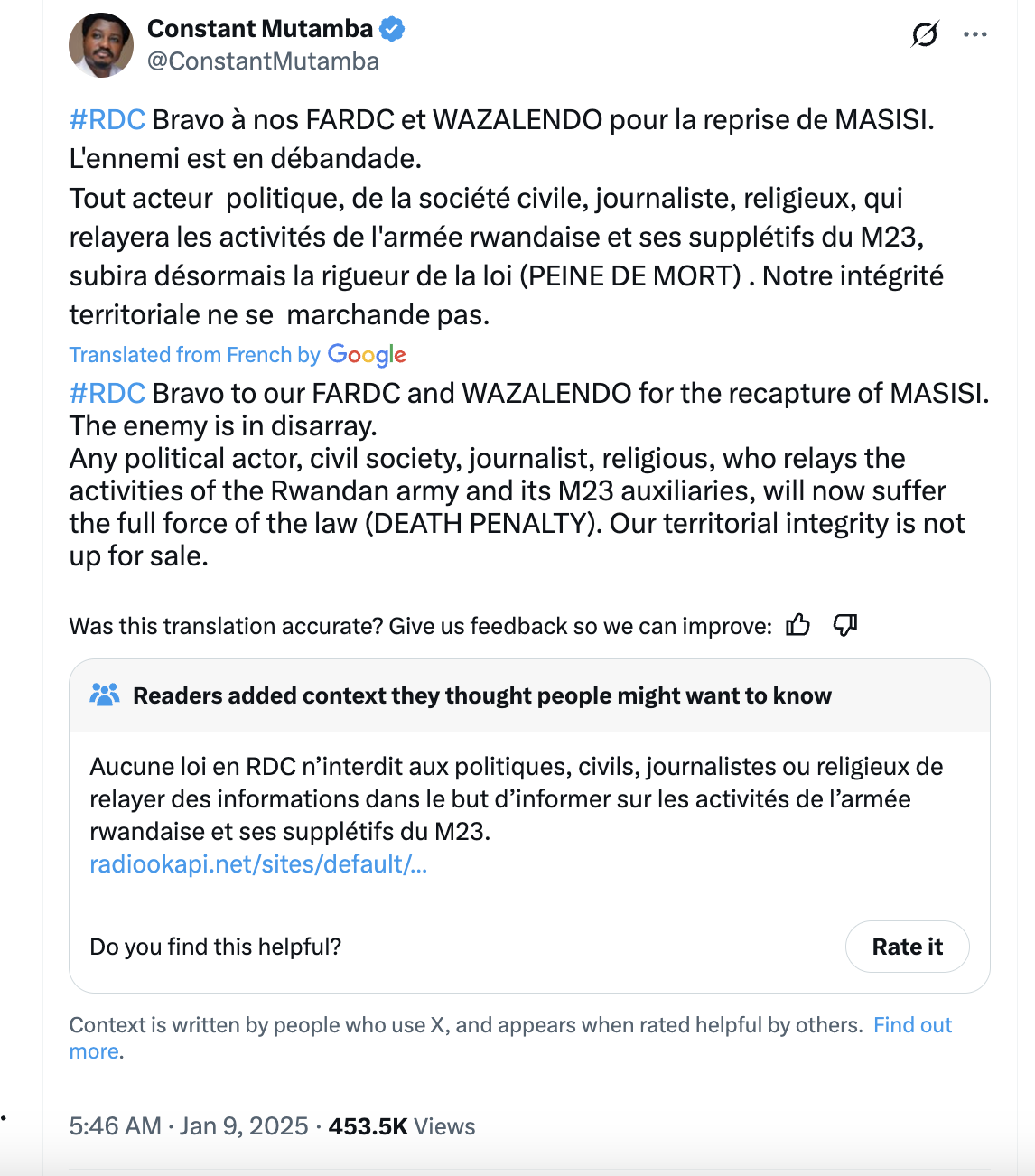
As far as Radio Okapi is concerned, its journalists either apply self-censorship or receive editorial and content directives directly from Kinshasa. Indeed, when the news update on the alleged “brutality of M23” in Goma was published at 5:37am on March 29th, it was accompanied by the picture of Congolese police officers simulating the capture of an individual.
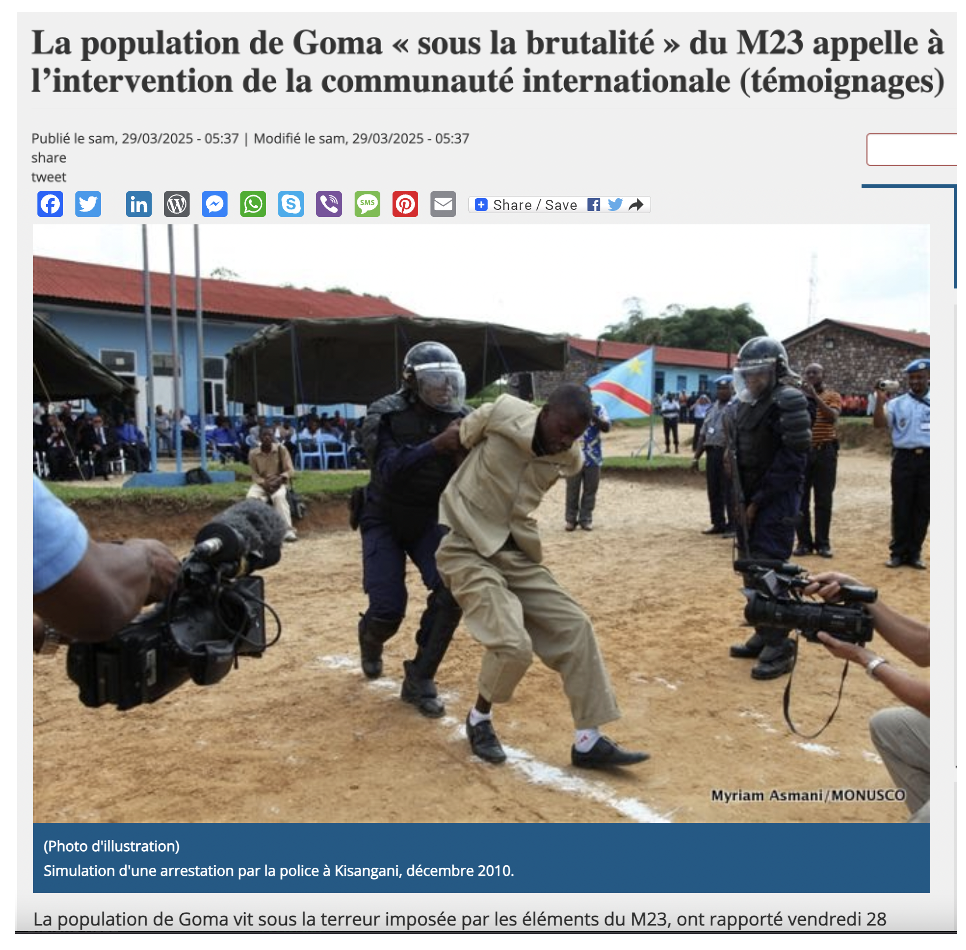
About 6 hours later, at 11:58 am, that picture was removed and replaced by one representing a street in Goma.
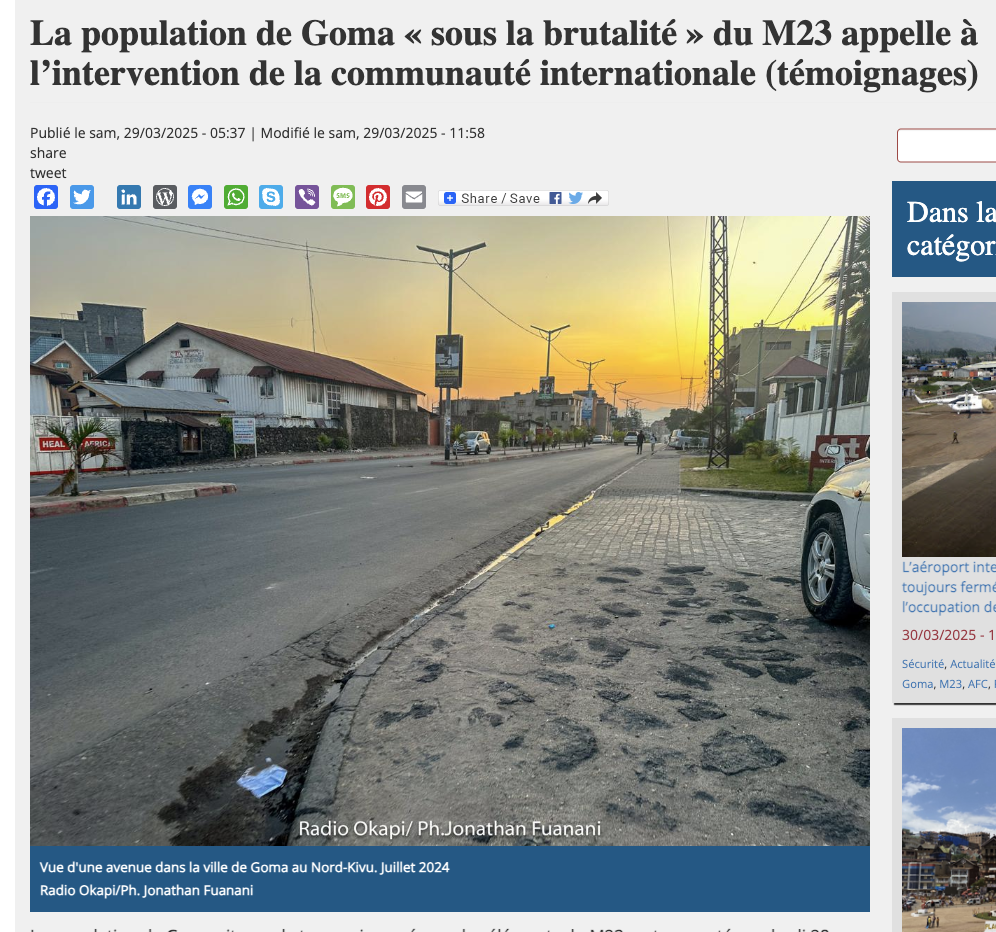
It is true that when speaking of “brutality of M23”, while not being able to find a picture to represent it, but instead using the representation of “brutality of M23” with a picture of Congolese national security forces, could certainly be a red line for Kinshasa.
In view of such a context of absence of freedom of press, where a number of journalists have either been banned or are in exile for fear of getting abducted like Stanis Bujakera, or tortured and killed, added to MONUSCO’s partisan role in the conflict, Radio Okapi cannot constitute a credible source of information on the DRC conflict. This context also highly informs the regional and international community about the partisan role of MONUSCO and the UN Security Council in the DRC crisis. The propaganda which is disseminated by the UN Radio Okapi questions the neutrality of MONUSCO and its ensuing attack on Rwanda, a UN member state.